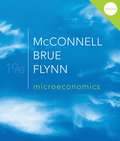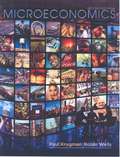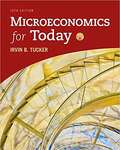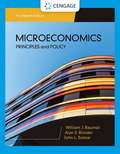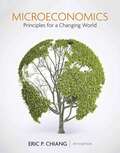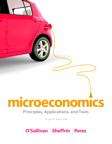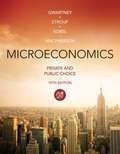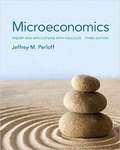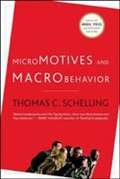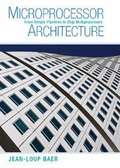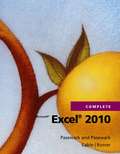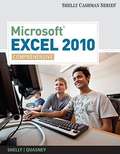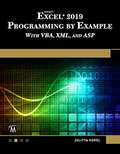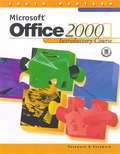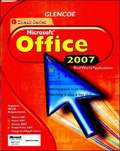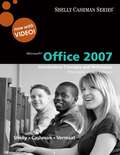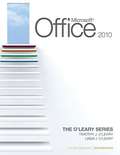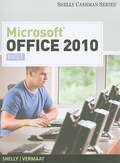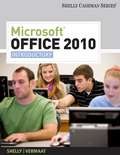- Table View
- List View
Microeconomics (Nineteenth Edition)
by Stanley L. Brue Campbell Mcconnell Sean Masaki FlynnMcConnell, Brue, and Flynn' s Economics: Principles, Problems, and Policies is the #1 Principles of Economics textbook in the world. It continues to be innovative while teaching students in a clear, unbiased way. The 19th Edition builds upon the tradition of leadership by sticking to 3 main goals: Help the beginning student master the principles essential for understanding the economizing problem, specific economic issues, and the policy alternatives; help the student understand and apply the economic perspective and reason accurately and objectively about economic matters; and promote a lasting student interest in economics and the economy. Connect is the only integrated learning system that empowers students by continuously adapting to deliver precisely what they need, when they need it, and how they need it, so that your class time is more engaging and effective.
Microeconomics 2nd Edition
by Paul Krugman Robin WellsThe product of the partnership of coauthors Krugman and Robin Wells, the book returns in a new edition. The new edition is informed and informative, solidly grounded in economic fundamentals yet focused on the realities of today's world and the lives of students. It maintains the signature Krugman/Wells story-driven approach while incorporating organizational changes, new content and features, and new media and supplements.
Microeconomics for Today
by Irvin B. TuckerThe most reader-friendly economics approach available, MICROECONOMICS FOR TODAY, 10E by national award-winning educator Irvin Tucker presents Macro and Micro economic concepts using a writing style that is both engaging and clear, no matter what your current level of economic understanding. <p><p> A unique presentation and visual learning system, colorful graphs, and Causation Chains clarify and illustrate important economic principles. The book concisely presents and reinforces core concepts, while online resources immediately facilitate assessment of understanding, and will study the latest information on economic growth, income distribution, federal deficits, environmental issues, and other developments in economics today. <p><p> The book's easy-to-follow format demonstrates how to apply principles to your everyday life, while numerous printed and digital study tools help you further master key current economic principles.
Microeconomics: Principles and Policy (MindTap Course List)
by Alan Blinder William Baumol John SolowMaster today's principles of microeconomics and gain an understanding of current economic issues and their importance as Baumol/Blinder/Solow's MICROECONOMICS: PRINCIPLES AND POLICY, 14E provides a solid introduction to microeconomics using policy-based examples and applications. Written by several of today's most respected economists, this book is one of the most up-to-date microeconomics choices on the market -- incorporating data and issues as recent as 2018. The authors combine the right level of rigor and detail to clarify even the most complicated microeconomics concepts. An entirely new chapter closes the book by delving into some of the most important issues confronting the U.S. economy today. Throughout this edition, well-developed examples, intriguing puzzles and meaningful microeconomics issues provide an excellent balance of theory to application while keeping you engaged and intrigued.
Microeconomics: Principles for a Changing World
by Eric ChiangWith this edition, Eric Chiang continues to link economics concepts to topics of personal interest to students. The new edition is a thoroughly contemporary, fully integrated print/technology resource that adapts to the way you want to teach. As always, this concise book focuses on the topics most often covered in the principles course, but with this edition, it offers a stronger emphasis than ever on helping students apply an economic way of thinking to the overwhelming flow of data we face every day. <p><p>Economics: Principles for a Changing World is fully informed by Eric Chiang’s experiences teaching thousands of students worldwide, both in person and online. Developing the text, art, media, homework, and ancillaries simultaneously, Chiang translates those experiences into a cohesive approach that embodies the book’s founding principles:
Microeconomics: Principles, Applications, and Tools (Eighth Edition)
by Arthur O'Sullivan Steven M. Sheffrin Stephen J. PerezFor Principles of Microeconomics courses. Microeconomics: Principles, Applications, and Tools, is also suitable for economists, financial analysts and other finance professionals. Questions that drive interest, applications that illustrate concepts, and the tools to test and solidify comprehension. Students come into their first Economics course thinking they will gain a better understanding of the economy around them. Unfortunately, they often leave with many unanswered questions. To ensure students actively internalize economics, O'Sullivan/Sheffrin/Perez use chapter-opening questions to spark interest on important economic concepts, applications that vividly illustrate those concepts, and chapter-ending tools that test and solidify understanding.
Microeconomics: Private and Public Choice (Fifteenth Edition)
by James D. Gwartney David A. Macpherson Russell S. Sobel Richard L. StroupMICROECONOMICS: PRIVATE AND PUBLIC CHOICE, Fifteenth Edition, reflects current economic conditions, enabling you to apply economic concepts to the real world. The up-to-date text includes analysis and explanation of measures of economic activity in today's market. It also includes highlights of the recession of 2008-2009, and an in-depth look at the lives and contributions of notable economists. MICROECONOMICS: PRIVATE AND PUBLIC CHOICE dispels common economic myths. The text uses the "invisible hand" metaphor to explain economic theory, demonstrating how it works to stimulate the economy. The fifteenth edition includes online learning solutions to improve your learning outcomes. Graphing tutorials and videos embedded within the interactive reader support your classroom work and improve your performance.
Microeconomics: Theory and Applications with Calculus
by Jeffrey M. PerloffFor all intermediate Microeconomics courses at the undergraduate or graduate level. This text is also suitable for readers interested in calculus-based intermediate microeconomics. <P><P> Understand the practical, problem-solving aspects of microeconomic theory. Microeconomics: Theory and Applications with Calculus uses calculus, algebra, and graphs to present microeconomic theory using actual examples, and then encourages readers to apply the theory to analyze real-world problems. The Third Edition has been substantially revised, 80% of the Applications are new or updated, and there are 24 new Solved Problems. Every chapter (after Chapter 1) contains a new feature (the Challenge and the Challenge Solution) and has many new end-of-chapter exercises.
Micromotives and Macrobehavior (Updated Edition)
by Thomas C. SchellingMicromotives and Macrobehavior was originally published over twenty-five years ago, yet the stories it tells feel just as fresh today. And the subject of these stories -- how small and seemingly meaningless decisions and actions by individuals often lead to significant unintended consequences for a large group -- is more important than ever. In one famous example, Thomas C. Schelling shows that a slight-but-not-malicious preference to have neighbors of the same race eventually leads to completely segregated populations. The updated edition of this landmark book contains a new preface and the author's Nobel Prize acceptance speech.
Microprocessor Architecture: From Simple Pipelines to Chip Multiprocessors
by Jean-Loup BaerThis book gives a comprehensive description of the architecture of microprocessors from simple in-order short pipeline designs to out-of-order superscalars. It discusses topics such as - the policies and mechanisms needed for out-of-order processing such as register renaming, reservation stations, and reorder buffers - optimizations for high performance such as branch predictors, instruction scheduling, and load-store speculations - design choices and enhancements to tolerate latency in the cache hierarchy of single and multiple processors - state-of-the-art multithreading and multiprocessing emphasizing single chip implementations Topics are presented as conceptual ideas, with metrics to assess the performance impact, if appropriate, and examples of realization. The emphasis is on how things work at a black box and algorithmic level. The author also provides sufficient detail at the register transfer level so that readers can appreciate how design features enhance performance as well as complexity.
Microsoft Excel 2010 Complete
by Beth Pasewark Wadsworth Carolyn Denny Pasewark Jan Pasewark Stogner Scott G. Pasewark William R. Pasewark Sr. William R. Pasewark Jr. Robin M. Romer Sandra CableMicrosoft Excel 2010 Complete is designed for beginning users. It demonstrates the tools and features for this program in an easy-to-follow, hands-on approach. Students will learn to use the application through a variety of activities, simulations, and case projects. This self-paced, step-by-step book makes learning easy and enjoyable. End-of-lesson exercises reinforce the content covered in each lesson and provide students with the opportunity to apply the skills that they have learned.
Microsoft Excel 2010, Comprehensive
by Gary B. Shelly Steven M. Freund Jeffrey J. Quasney Raymond E. Enger Mali B. JonesMicrosoft Office Excel 2010, Comprehensive provides a project-based, step-by-step approach to teach students Microsoft Excel 2010 skills.
Microsoft Excel 2010: Marquee Series
by Audrey Rutkosky Roggenkamp Denise Seguin Nita RutkoskyThis book outlines how to organize, analyze, and present data in Microsoft Excel 2010.
Microsoft Excel 2019 Programming by Example: With VBA, XML, and ASP
by Julitta KorolUpdated for Excel 2019 and based on the bestselling editions from previous versions, Microsoft Excel 2019 Programming by Example with VBA, XML and ASP is a practical, how-to book on Excel programming, suitable for readers already proficient with the Excel user interface (UI). The book includes companion files with all of the source code and figures used in the text (available with Amazon proof of purchase by writing to the publisher at info@merclearning.com.) <p><p> If you are looking to automate Excel routine tasks, this book will progressively introduce you to programming concepts via numerous illustrated hands-on exercises. More advanced topics are demonstrated via custom projects. From recording and editing a macro and writing VBA code to working with XML documents and using Classic ASP pages to access and display data on the Web, this book takes you on a programming journey that will change the way you work with Excel. The book provides information on performing automatic operations on files, folders, and other Microsoft Office applications. It also covers proper use of event procedures, testing and debugging, and guides you through programming advanced Excel features such as PivotTables, PivotCharts, and the Ribbon interface.
Microsoft Office 2000: Introductory Course
by William R. Pasewark Sr. William R. Pasewark Jr.This comprehensive text offers a thorough introduction to the four main Microsoft Office 2000 applications plus Outlook. The coverage of Word and Excel provide Proficient level certification for the Microsoft Office User Specialist (MOUS) certification program.
Microsoft Office 2007, Real World Applications
by C. Jacqueline Schultz Linda WooldridgeiCheck Microsoft Office 2007is an engaging top-bound text which provides students with applications that apply to everyday life! Written specifically for high school students, this rigorous series provides extensive step-by-step exercises and projects that prepare students for MCAS certification. It is age-level and interest-level appropriate. The student edition includes integration of basic language arts and mathematics skills.
Microsoft Office 2007: Introductory Concepts and Techniques
by Gary B. Shelly Thomas J. Cashman Misty E. VermaatThis book is intended for a first course on Office 2007 applications and to expose students to practical examples of the computer, to acquaint students with the proper procedures to create documents, worksheets through an exercise-oriented approach.
Microsoft Office 2010
by Audrey Rutkosky Roggenkamp Denise Seguin Nita RutkoskyNIMAC-sourced textbook
Microsoft Office 2010
by Audrey Rutkosky Roggenkamp Denise Seguin Nita RutkoskyMarquee Series, Microsoft Office 2010 prepares students to work with Microsoft Office 2010 in a business office or for personal use. Incorporating an accelerated, step-by-step, project-based approach, this text builds student competency in Word, Excel, Access, and PowerPoint 2010 and the essential features of Windows 7 and Internet Explorer 8.0.
Microsoft Office 2010 Illustrated First Course Introductory
by Jennifer Duffy Lisa Friedrichsen Elizabeth Eisner Reding Carol M. Cram David W. BeskeenLoved by instructors for its visual and flexible way to build computer skills, the Illustrated Series is ideal for teaching Microsoft Office 2010 to both computer rookies and hotshots. Each two-page spread focuses on a single skill, making information easy to follow and absorb. Large, full-color illustrations represent how the students' screen should look. Concise text introduces the basic principles of the lesson and integrates a case study for further application.
Microsoft Office 2010: A Case Approach (Introductory Edition)
by Timothy J. O'Leary Linda I. O'Leary"Timothy and Linda O'Leary and the Computer Information Technology Team at McGraw-Hill Higher Education offer your students a fully integrated learning program with time-tested quality and reliability. Office 2010: A Case Approach offers running case study throughout the text to help students understand the material in a consistent, relevant environment. Through this theme of "Making Office Relevant," this text helps students understand why they need this course and these skills. Updated for Office 2010, student success is assured through clear step-by-step instruction, plentiful screen captures and conceptual explanations. Each Lab, designed to be covered in 1 hour of class time, combines conceptual coverage with detailed software-specific instructions. Each Lab opens with a running case study that highlights real-world applications of each software program and leads students from problem to solution. Moreover, 25-50% of all end of chapter exercises are completely new. The O'Leary Series helps students learn specific applications skills along with those that cross all Office applications, which is especially important in mastering this version of Office. The O'Leary Series also correlates with SimNet Online, our online training and assessment program for Office 2010"-- "As we begin the 21st century, computer literacy is undoubtedly becoming a prerequisite in whatever career you choose. The goal of the O'Leary Series is to provide you with the necessary skills to efficiently use these applications. Equally important is the goal to provide a foundation for students to readily and easily learn to use future versions of this software. This series does this by providing detailed step-by-step instructions combined with careful selection and presentation of essential concepts. Times are changing, technology is changing, and this text is changing too. As students of today, you are different from those of yesterday. You put much effort toward the things that interest you and the things that are relevant to you. Your efforts directed at learning application programs and exploring the Web seem, at times, limitless. On the other hand, students often can be shortsighted, thinking that learning the skills to use the application is the only objective. The mission of the series is to build upon and extend this interest by not only teaching the specific application skills but by introducing the concepts that are common to all applications, providing students with the confidence, knowledge, and ability to easily learn the next generation of applications.
Microsoft Office 2010: Brief
by Gary B. Shelly Misty E. VermaatAs one of the books in The Shelly Cashman Series® on computer education, Microsoft Office 2010: Brief provides a project-based, step-by-step approach to teaching the Office 2010 applications and offers a number of new features and approaches, which improve student understanding retention transference, and skill in using Office 2010 programs.
Microsoft Office 2010: Introductory (Shelly Cashman Series)
by Gary B. Shelly Misty E. VermaatMicrosoft Office 2010: Introductory provides a project-based, step-by-step approach to teaching the Office 2010 applications.
Microsoft Office 2010: Marquee Series (Brief Edition)
by Audrey Rutkosky Roggenkamp Denise Seguin Nita RutkoskyMarquee Series, Microsoft Office 2010 prepares students to work with Microsoft Office 2010 in a business office or for personal use. Incorporating an accelerated, step-by-step, project-based approach, this text builds student competency in Word, Excel, Access, and PowerPoint 2010 and the essential features of Windows 7 and Internet Explorer 8.0.
